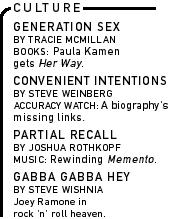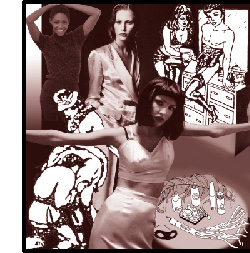

|

|

|

|
| |
|
|
|
Her Way: Young Women Remake the Sexual Revolution Sex. We all know it's everywhere, it's used to sell everything, and pretty much everybody does it. But the motivations, guilt, detractions and rewards women associate with it have been little more than topics of the occasional barroom exchange, classroom pontification or slumber party confession. Which is where Paula Kamen's Her Way: Young Women Remake the Sexual Revolution (jacketed in girl-friendly purple and pink), finds its niche. Forthrightly focused on young women's attitudes toward sex, Her Way beckons as a potentially juicy tome on the sexual habits and practices of American women. But Kamen, an academic and journalist by trade (and an In These Times contributor), accumulates plenty of data to space out the occasional sensational tidbit, keeping the book from a more salacious fate. In place of a sticky sweet tell-all, we get a detailed report on the sexual landscape of American women--informative, impressively data-laden and occasionally difficult to wade through. The overarching question behind Her Way is a simple one: How do the young women
And women's individual choices have become heavily weighted toward having sex earlier--and usually before marriage. The new choice-centered sexuality resolutely departs from previous generations' greater adherence to sexual scripts; good girls can do "it"--and want "it"--along with the bad ones these days. Far from being tied to moral mandates stemming from rigid ideologies or religion, women's sexual behavior has come to be defined by their own sense of morality and comfort. And for the many women for whom religion plays a significant factor in sexual choices, it's clear that young women cherry-pick their way through religious doctrine, discarding the tenets that conflict with their own sense of self while embracing the parts that still make sense. At the heart of it is a trust, again, in individual choice and morality. The "postboomers" enjoy far greater freedom to experiment with, explore and experience sex on their own terms. Kamen parades an impressive array of statistics, showing that women are more likely to know what turns them on, to expect an orgasm from sex, and to have sex outside of marriage. For instance, 69 percent of women who married between 1965 and 1974 had their first intercourse outside of marriage, compared to 89 percent of women married in the early '90s. Along with other data--showing an average of 5 to 10 sexual partners for young women over their lifetime, for example--Kamen marches out stats showing everything from whether oral sex is on the rise (it is, but more for the non-married crowd) to whether single motherhood is increasing (it is, especially for white women). In many cases, women are choosing to pursue sexual paths that mimic the traditionally male scripts: casual sex, multiple partners, disconnecting sex from emotion. This is most obvious, Kamen says, in the emergence of what she terms the "superrats" ("super" because they characterize a development pattern of future generations, "rat" because they are considered "noisome and disruptive"). This new breed of young women are aggressive and open, with little sense of guilt over their behavior in and out of bed. The final conclusion is something that, by and large, anyone who has watched Sex and the City or simply been single in recent years has probably figured out: Sexual behavior, ranging from solid virgin status to group sex, has been relegated to personal choice. The questions that remain are: So what? Why does this matter? How does it impact on the rest of the social picture? To her credit, Kamen lightly touches on some of the more disturbing implications of such wholeheartedly individualistic inclinations: Namely, that while the vastly expanded sexual freedom available to women is a direct result of political struggle, few young women make the connection between what is now a personal choice and the political battles that made that choice possible. In the book's conclusion, Kamen devotes just three paragraphs to social consciousness and activism. Most tellingly, the final sentence of the section, seemingly tagged on as an afterthought, reads: "I'm not suggesting the creation of a communist state, but we do need some basic safety nets and more recognition of the interdependence of everyone in society." It's a good point; after all, if all these women are emphasizing that everything needs to be individualized, then what happens to things like social provision? Still, it would have been better to see a somewhat more coherent and powerful analysis of the political implications of this incredibly individualized generation of women. Kamen is fond of discussing the male-female divide in sexual behavior; indeed, her conclusion is rife with it, and she goes so far as to say that disconnecting sex from the "rest of human experience" is a male trait, and one which women would do well to stay away from. This kind of essentializing rhetoric is a bit difficult to swallow; after all, plenty of young feminists have argued for separating sex and love, largely to increase women's freedom to experiment with their physical pleasure. Kamen oversimplifies things, and while there should be no shame in wanting an emotional connection in tandem with sex, she borders on chastising those who don't have the need for one. The most frustrating thing about Her Way, aside from its occasional tendency to drag on, is that while Kamen goes out of her way to note that not all women's experiences are the same, it's not carried throughout the book. Kamen dutifully notes, over the course of about four pages, that all women have begun to act more like men, and that the greatest changes have occurred for white middle-class women. What would have been good is to have a more coherent and consistently acknowledged outline of differences between the white middle-class "norm" and women of other races and classes. The book ends up feeling like it's about white women, even though Kamen has done her homework and, early on, made the necessary disclaimer that different women have different experiences. For instance, Kamen ends an early chapter by noting that women are no longer being "swept away" by sex--a dynamic that in many ways is limited to white, middle-class women. But in the end, Her Way is still a useful text, and it is
sure to make its way into women's studies courses. This kind of
meticulous data gathering, particularly on this topic, is rare.
Her Way will not fill an inspirational void, but you'll be hard-pressed
to find a more informative collection of data and personal anecdotes
on the state of women and sex in America. Tracie McMillan is the editor of the activist, the magazine of the Young Democratic Socialists. She can be reached at theactivist@bigfoot.com.
|


